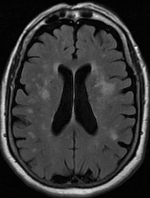
Photo from wikipedia
BACKGROUND AND OBJECTIVE Stroke lesion volume is a key radiologic measurement in assessing prognosis of acute ischemic stroke (AIS) patients. The aim of this paper is to develop an automated… Click to show full abstract
BACKGROUND AND OBJECTIVE Stroke lesion volume is a key radiologic measurement in assessing prognosis of acute ischemic stroke (AIS) patients. The aim of this paper is to develop an automated segmentation method for accurately segmenting follow-up ischemic and hemorrhagic lesion from multislice non-contrast CT (NCCT) volumes of AIS patients. METHODS This paper proposes a 2D dense multi-path contextual generative adversarial network (MPC-GAN) where a dense multi-path 2D U-Net is utilized as the generator and a discriminator network is applied to regularize the generator. Contextual information (i.e., bilateral intensity difference, distance map and lesion location probability) are input into the generator and discriminator. The proposed method is validated separately on follow-up NCCT volumes of 60 patients with ischemic infarcts and NCCT volumes of 70 patients with hemorrhages. RESULTS Quantitative results demonstrated that the proposed MPC-GAN method obtained a Dice coefficient (DC) of 70.6% for ischemic infarct segmentation and a DC of 76.5% for hemorrhage segmentation compared with manual segmented lesions, outperforming several benchmark methods. Additional volumetric analyses demonstrated that the MPC-GAN segmented lesion volume correlated well with manual measurements (Pearson correlation coefficients were 0.926 and 0.927 for ischemic infarcts and hemorrhages, respectively). CONCLUSIONS The proposed MPC-GAN method can accurately segment ischemic infarcts and hemorrhages from NCCT volumes of AIS patients.
Journal Title: Physics in medicine and biology
Year Published: 2020
Link to full text (if available)
Share on Social Media: Sign Up to like & get
recommendations!